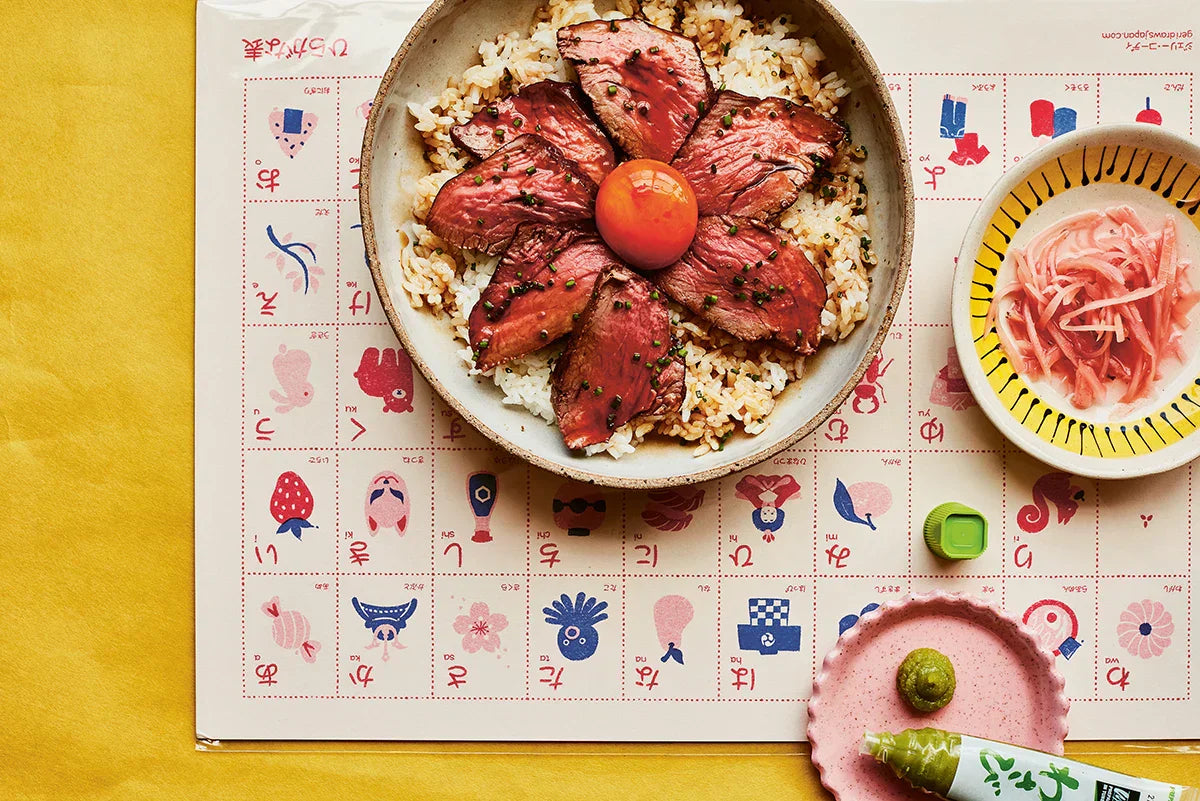
Prep Time: 10-15 minutes
Cooking Time: 10-15 minutes (depending on steak thickness and how well-done you prefer it)
Total Time: 20-30 minutes
Serving Size: 2 servings
TOKUSEI GYŪDON 特製牛丼
Warishita is the name of a sauce made by seasoning dashi with generous quantities of soy sauce, sake, mirin and sugar. It is sort of like the lovechild of teriyaki sauce and tsuyu, most commonly used in the perennially popular beef hotpot, sukiyaki. Here, it is used to deglaze the pan after frying a steak, then mixed with butter and topped with an egg yolk for a truly decadent take on the humble gyūdon (beef bowl).
Ingredients:
- a few drops of sesame oil
- 4 tablespoons soy sauce
- 2 egg yolks
- 3 tablespoons sake
- 3 tablespoons water
- 2 tablespoons mirin
- 1 tablespoon brown sugar
- ½ teaspoon dashi powder
- 1 very large steak, or two smaller ones – about 400 g (14 oz) in total, any cut you like
- salt and pepper, as needed
- oil, as needed
- 10 g (1/2 oz) butter; more if you’re using quite lean steak, or if you just really like butter
- 2 portions of cooked rice
- handful of chives, finely chopped (optional)
- wasabi, to taste (optional)
- pickled ginger, to garnish
Method:
- Grease a couple of ramekins or similar small containers with sesame oil
- Divide 1 tablespoon soy sauce between them
- Carefully place the egg yolks in each cup and leave to cure lightly while you prepare the rest of the meal
- Combine the remaining 3 tablespoons soy sauce with the sake, water, mirin, sugar and dashi powder and stir well to dissolve
- Season the steak on all sides with salt and pepper
- In a lightly oiled frying pan (skillet) set over a high heat
- Cook the steak to your liking – if you’re going for a very thick steak, this should take about 10 minutes, turning the steak every minute. Remember to err on the side of rare – if you cut into it and it’s not done, you can keep cooking it, but if it’s overdone, there’s no going back
- Remove the steak from the pan and remove the pan from the heat
- Leave the pan to cool slightly, then add the sauce and bring to the boil
- Add the butter and whisk it into the sauce as it melts
- Keep the sauce at a low simmer until ready to serve
- Slice the steak very thinly and arrange the slices in a circle on top of each bowl of hot rice
- Place an egg yolk in the middle of each bowl, then spoon over the sauce
- Garnish with the chopped chives and a dab of wasabi and pickled ginger on the side, if using, and serve piping hot
This lasts up to three days in the refrigerator, but it’s really best eaten immediately.
JapanEasy Bowls & Bento by Tim Anderson (Hardie Grant, £25), Photography by Laura Edwards.
Tim Anderson is a chef, writer, and MasterChef champion.
Born and raised in Wisconsin, Tim has been studying Japanese food culture for more than two decades, first as a hobby, then as a profession. He majored in Japanese Studies at university, where he was awarded a grant to conduct independent research on local food museums in Japan. Subsequently, he lived in Fukuoka prefecture for two years to further pursue his interest in Japanese food, and then moved to London, where he won MasterChef in 2011. In 2015 Tim opened the Japanese ramen izakaya restaurant Nanban and published his first book, Nanban: Japanese Soul Food. He has since left the restaurant, but has gone on to publish eight more books, including Ramen Forever, the JapanEasy series, Your Home Izakaya, and Tokyo Stories, for which Tim won the John Avery prize at the Andre Simon Awards.

